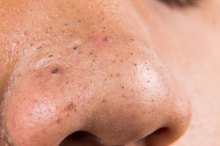What does fact checked mean?
At Healthfully, we strive to deliver objective content that is accurate and up-to-date. Our team periodically reviews articles in order to ensure content quality. The sources cited below consist of evidence from peer-reviewed journals, prominent medical organizations, academic associations, and government data.
- MayoClinic.com: Omega-3 Fatty Acids, Fish Oils, Alphalinolenic Acid
- National Center for Biotechnology Information: Cod-liver Oil for Burns
- National Center for Biotechnology Information: Cod-liver Oil for Burns
The information contained on this site is for informational purposes only, and should not be used as a substitute for the advice of a professional health care provider. Please check with the appropriate physician regarding health questions and concerns. Although we strive to deliver accurate and up-to-date information, no guarantee to that effect is made.
How to Rub Fish Oil on Scars
Rich in omega-3 fatty acids and eicosapentaenoic acid, fish oil is a type of oil derived from the skin and tissues of certain types of fish 2. While frequently taken internally in softgel tablet form, fish oil is sometimes also recommended for topical application for the removal of scars and stretch marks. When punctured with a pin or other small device, the fish oil can be mixed with the contents of a Vitamin E softgel tablet for a quick-healing concoction for the skin. With patience, practice and an attention to detail, practically anyone can effectively help their scars with fish oil.
Designate a clean working area with sufficient light for preparing your fish oil ointment. If applying the oil on yourself, position a mirror so that you can clearly see the scarred section of skin in the reflection.
How to Apply Vitiman E Oil to Dark Spots
Learn More
Puncture the fish oil tablet with a safety pin and carefully squeeze out the oil on a small bowl or plate. Press the sides of the tablet until all of the oil has been removed. Impale the skin of the vitamin E tablet and empty out the contents in the same way on top of the fish oil. Shake the bowl or stir with your finger to mix the two liquids.
Locate the scarred area in the mirror, and make sure the area is dry and clean of any dirt by rubbing with a towel. Insert your finger into the oil mixture, and gently apply it to the scarred area. If you do not wish to use your finger, one end of a cotton swab can be dipped into the mixture and applied.
Does Rubbing Vitamin E on the Face Help Wrinkles?
Learn More
Rub the oil mixture gently in a circular motion around the scar, and continue applying until the scar is saturated in the oil mixture. Let dry.
Tips
Apply the mixture three to four times a day. See your dermatologist if the scar persists beyond a week of fish oil application.
Warnings
If the oil mixture falls into your eyes, flush the effected eye immediately with water.
Related Articles
References
- National Center for Biotechnology Information: Cod-liver Oil for Burns
- The University of Maryland Medical Center: Omega-3 Fatty Acids
- American Heart Association. Getting Healthy. Fish and Omega-3 Fatty Acids. Updated March 23, 2017.
- U.S. Department of Agriculture. FoodData Central.
- National Institutes of Health. National Center for Complementary and Integrative Health. 7 things to know about omega-3 fatty acids. Updated October 9, 2019.
- Rizos EC, Ntzani EE, et al. Association Between Omega-3 Fatty Acid Supplementation and Risk of Major Cardiovascular Disease Events A Systematic Review and Meta-analysis. JAMA. 2012;308(10):1024-1033. doi:10.1001/2012.jama.11374
- Natural Resources Defense Council. Nicole Greenfield. The smart seafood buying guide: five ways to ensure the fish you eat is healthy for you and for the environment. Updated August 26, 2015.
Resources
Writer Bio
Based in the Appalachian Mountains, Brian Connolly is a certified nutritionist and has been writing professionally since 2000. He is a licensed yoga and martial arts instructor whose work regularly appears in “Metabolism,” “Verve” and publications throughout the East Coast. Connolly holds advanced degrees from the University of North Carolina, Asheville and the University of Virginia.









